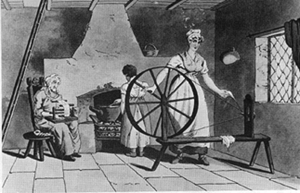The Domestic System

Before the Industrial Revolution, products were largely manufactured in a domestic system. In a domestic system, work is contracted to people who carry it out in their own homes. One of the most common cottage industry was textile manufacturing, including the production of wool.
This was the process of making wool for clothes:
Sheep were sheared for their wool, which was then cleaned. Then, the carding of the wool would involve brushing it into separate fibres. A comb would be used to get the fibres parallel. Once it has been cleaned and combed, the wool would be spun by a team of spinsters, which usually consisted of unmarried girls - thus explaining the use of term spinster in today’s language for a single woman. The finished product was called yarn. The yarn would be woven by a specialist and skilled worker, known as a weaver, who would use a handloom. And finally, once this process was complete, the woven yarn would then be sold to a clothier.
There were advantages to the domestic system. For one, workplace conditions tended to be much better than those in factories. Furthermore, in the domestic system people could work at their own speed and did not have demanding targets or bosses, therefore allowing them to take breaks and rest when they needed to. It was also practical. Before the Industrial Revolution it was often impractical to travel far to work owing to the state of the roads and footpaths.
However, as Britain’s industrial power increased, the weaknesses in the domestic system made it untenable.
There was no way that cottage industries could keep up with demand. A better and faster system of production was needed. What’s more, the domestic system did not always provide people with a high quality of life. Defoe witnessed unsanitary living and working conditions and children, some who were only four years old, were working in the domestic system.
Due to the increasing population, there was greater demand for food and clothing, so a new approach was required. In the Industrial Revolution, factories, shipbuilding ports and mines would gradually replace the domestic system.
MLA Citation/Reference
"The Domestic System". HistoryLearning.com. 2024. Web.
